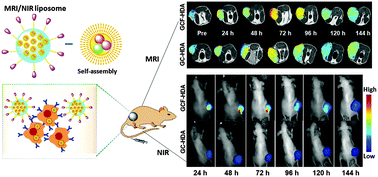A bimodal MRI and NIR liposome nanoprobe for tumor targeted molecular imaging†
Abstract
The combination of complementary MRI and NIR imaging methods evolved to provide an even more powerful bioimaging tool. Herein, a novel bimodal MRI/NIR nanoprobe GCF-HDA was prepared via a facile self-assembly approach of three types of amphiphilic structures in aqueous solution. The Stokes shift of the NIR moiety increased from 30 to 150 nm and fluorescence quantum yield increased from 1.5 to 8% after conjugation with electron-rich hexadecylamine (HDA) to organic dye Cy7. The photostability of the nanoprobe GCF-HDA was dramatically improved after involving the newly synthesized dye. Molecular dynamics simulation demonstrated that the GCF-HDA is composed of 2.0–3.5 nm clusters and in each cluster the head groups of the amphiphilic molecules assemble together and the tail groups point outwards. The r1 and r2 relaxivities of GCF-HDA were found to be 11.87 and 19.91 mM−1 s−1 per Gd(III) chelate at 0.5 T, respectively. In vitro cellular imaging with human glioma U-87 MG cells showed that the GCF-HDA was able to enter the cells and accumulate in the cytoplasm. The targeted GCF-HDA resulted in higher MR contrast enhancement and stronger fluorescence intensity than the corresponding non-targeted probe GC-HDA in the tumor tissue 96 hours post injection. Ex vivo fluorescence imaging and histological analysis of the tumor tissue further confirmed the specific binding ability of the GCF-HDA.


 Please wait while we load your content...
Please wait while we load your content...